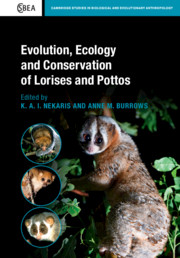Book contents
- Evolution, Ecology and Conservation of Lorises and Pottos
- Cambridge Studies in Biological and Evolutionary Anthropology
- Evolution, Ecology and Conservation of Lorises and Pottos
- Copyright page
- Dedication
- Contents
- Contributors
- Foreword
- Acknowledgements
- 1 Introduction
- Part I Evolution, Morphology and the Fossil Record
- Part II Ecology and Captive Management
- Part III Research, Trade and Conservation
- 24 Trapping, Collaring and Monitoring the Lorisinae of Asia (Loris, Nycticebus) and Perodicticinae (Arctocebus, Perodicticus) of Africa
- 25 Evaluation of Field Techniques Used to Assess Populations of Pottos and Lorises
- 26 Occupancy Modelling as a Method to Study Slender Loris Density
- 27 Using Accelerometers to Measure Nocturnal Primate Behaviour
- 28 Distribution and Conservation Status of Slow Lorises in Indo-China
- 29 Wildlife Trade Research Methods
- 30 Online Imagery and Loris Conservation
- 31 Slow Lorises (Nycticebus spp.) as Photo Props on Instagram
- 32 Integrating Science and Puppetry to Inspire Teenagers in Rural Asia to Value Slow Lorises
- 33 Developing a Rescue and Rehabilitation Centre as a Reaction to the Extensive Illegal Wildlife Trade in Slow Lorises
- References
- Index
29 - Wildlife Trade Research Methods
from Part III - Research, Trade and Conservation
Published online by Cambridge University Press: 29 February 2020
- Evolution, Ecology and Conservation of Lorises and Pottos
- Cambridge Studies in Biological and Evolutionary Anthropology
- Evolution, Ecology and Conservation of Lorises and Pottos
- Copyright page
- Dedication
- Contents
- Contributors
- Foreword
- Acknowledgements
- 1 Introduction
- Part I Evolution, Morphology and the Fossil Record
- Part II Ecology and Captive Management
- Part III Research, Trade and Conservation
- 24 Trapping, Collaring and Monitoring the Lorisinae of Asia (Loris, Nycticebus) and Perodicticinae (Arctocebus, Perodicticus) of Africa
- 25 Evaluation of Field Techniques Used to Assess Populations of Pottos and Lorises
- 26 Occupancy Modelling as a Method to Study Slender Loris Density
- 27 Using Accelerometers to Measure Nocturnal Primate Behaviour
- 28 Distribution and Conservation Status of Slow Lorises in Indo-China
- 29 Wildlife Trade Research Methods
- 30 Online Imagery and Loris Conservation
- 31 Slow Lorises (Nycticebus spp.) as Photo Props on Instagram
- 32 Integrating Science and Puppetry to Inspire Teenagers in Rural Asia to Value Slow Lorises
- 33 Developing a Rescue and Rehabilitation Centre as a Reaction to the Extensive Illegal Wildlife Trade in Slow Lorises
- References
- Index
Summary
Wildlife trade, defined as the sale or exchange of animals or plants by people, affects a wide variety of flora and fauna around the globe. The scale of this trade ranges from transactions of a single animal or plant to the commercial trade of wildlife in their billions. Rapidly expanding human populations, increased per capita wealth, improvements in infrastructure, increased access to forest and wilderness areas, increased internet penetration levels, changing consumer preferences for wild meat or exotic pets and improved hunting and trapping technologies have led to an increase in the numbers of animals affected by this trade. Investigations into the sale of wildlife can be approached from a biological, socioeconomic, legal or human health perspective (Karesh et al., 2005; Linder et al., 2013), but are most frequently done for conservation and sustainable use reasons (Smith et al., 2009). These investigations are vital if we are to ensure the sustainable use of natural resources. Without knowing the number of animals or plants removed from the wild for trade, we cannot know if the trade is causing species to be overharvested to the point of extinction.
- Type
- Chapter
- Information
- Evolution, Ecology and Conservation of Lorises and Pottos , pp. 339 - 361Publisher: Cambridge University PressPrint publication year: 2020
- 2
- Cited by



